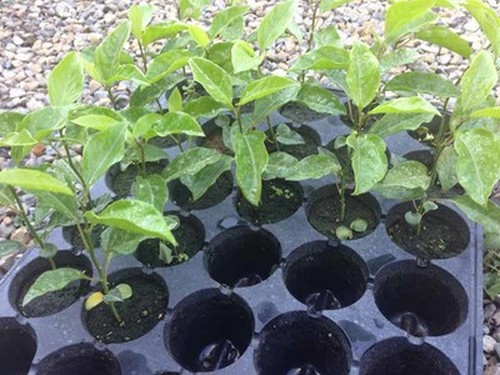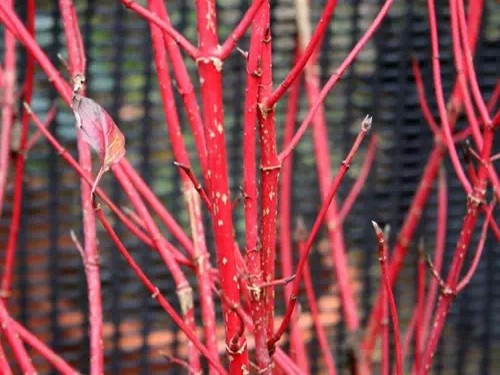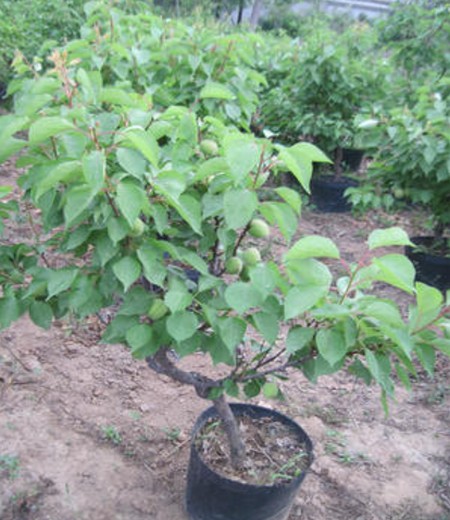Planting technique of passionflower (passion fruit)
Passionflower, also known as passion fruit, is a perennial vine that has no erect trunk and fixed tree shape and grows by climbing trees or other objects under natural conditions. Passionflower is a tropical fruit tree, which is not cold-resistant, likes light and high temperature. It is planted in the mountains of northern Guangdong and is cultivated seasonally. In order to obtain the planting effect of high quality, high yield and high efficiency, we must follow the natural law of climatic conditions, make full use of the seasonal light and temperature conditions, reasonably close planting and increase the yield per unit area.

The most suitable growth temperature of passion fruit is 20-30 ℃. It generally grows well at the temperature of no less than 0 ℃, and the plant will be seriously damaged or even die when it reaches-2 ℃. The area with annual average temperature above 18 ℃ is the most suitable for planting. The following is to introduce the planting techniques of Xi Panlian:
1. Cutting seedling raising technique
1. Cutting time. Generally choose to be carried out from the end of October to early December.
2. Cutting and cutting. Select the mature branches of the leaves, take two nodes, leave the leaves in the upper section, cut off the cutting mouth at the node by 2 cm, and cut off half of the large leaves; leave no leaves in the lower section and cut off under the node. After the cuttings are cut, soak in the rooting agent solution for 2 to 3 minutes (1 kg of water per gram of rooting powder), cut into the seedling ground or nutrition cup, the depth is 2/3 of the cup soil, and then pour enough water. The nutrient soil formula is field mud in the lower 2/3 of the nutrition cup and yellow mud in the upper 1/3.
3. Cuttage management. The nursery had better choose the greenhouse to cover the small shed, cover the film to keep warm, and reduce the light of the sunshade net. The nursery is raised, 1 meter wide and more than 15 centimeters high. The surface of the directly inserted seedling border should be covered with 2 cm yellow mud. Nutrition bag seedlings, loaded with soil, placed on the border surface and then inserted. The seedling farm should be kept moist and watered every 5 days. After sprouting (about 30 to 40 days after insertion), foliar fertilizer is sprayed every 10 days. 20% biogas slurry or 0.3% urea solution or other foliar fertilizer can be used. Watering should be done before spraying, and then spraying after watering to avoid damaging the seedlings. The temperature in the shed should be kept between 20 ℃ and 30 ℃, and the high temperature at noon should be ventilated and cooled. When the cuttings grow to 10 cm, they should be ventilated and planted in the middle of March.
II. Planting management
1. Prepare before planting. For mountain planting, it is necessary to dig holes with specifications of 80 cm long × 80 cm wide x 50 cm deep, and each hole is 5-8 kg organic fertilizer, or 50 kg farm manure (rotten pig, cow, chicken, sheep manure). Mix well with the hole soil and fill it into the hole, first fill a layer of weeds, and then fill the fertilizer soil, after filling, a 50 cm high mound There is no need to dig holes in the paddy field, put base fertilizer in the mud after ploughing, and then set up a 50 cm mound to prepare for planting.
2. Select disease-free seedlings. Remove the seedlings whose leaves are wrinkled and yellowed before planting, and then use the fungicide moroxyguanidine hydrochloride 5% soluble powder or nongshide (20% sodium dichloroisocyanurate), spray twice, once every 7 days, and then plant.
3. Planting. Nutrition bag seedlings, remove nutrition bags, non-woven bags do not need to remove bags, straight into the seedlings, sown immediately after being drenched in water. Keep the root system good when planting, bear fruit after planting, cover the grass and set the root water. The planting density can be 2.5 m × 2 m row spacing, or 2 m × 2 m.
4. After topdressing, 25 kg of mature farm manure and 5 kg of plant ash can be used to cover the soil.
5. Insert bamboo to draw vines. When the new tip grows to more than 30 centimeters, insert a bamboo pole on the side, fix the seedling vine with plastic rope, lead the vine upward, and erase the lower side vine of the main vine in time. Hit the top when the main vine grows to 1.5 meters and put it on the shelf with 2-3 side vines.
6. Bracket. Passionflower can choose greenhouse scaffolding, small scaffolding or hedge scaffolding, support materials can choose bamboo, cement column or steel column, according to local conditions. It is suggested that planting with small scaffolding can achieve the effect of early fruiting and high yield.
7. Topping and thinning branches. After the branches are on the shelf, leave 5-6 buds to top the branches that show buds. Lateral branches meristematic after topping, leaving 5-6 buds to top after budding. For the vegetative branches without flowers, leave 50 cm to top and cut off the extra ones. The old branches should be cut off in time after fruit picking.
8. Overwintering pruning. Passionflower blossoms after October 1 are difficult to mature and should be cut off as soon as possible. Winter pruning is carried out when the first frost appears in mid-and late December. When pruning, the main branches of the shelf surface are cut off by 50 cm, generally leaving 3-5 main branches, then the trunk and branches are pulled to the ground, rolled into a circle of 60 cm, tied with rope, covered with grass, and then covered with thin film to keep warm through the winter. The branches will be straightened and tied to the shelf at the end of February and the beginning of March next year.
III. Pest control
Passion fruit has strong resistance to diseases and insect pests, and occasionally found that the plant is infected with diseases and insect pests.
The main diseases are seedling quenching disease, mosaic disease, blight disease and stem rot disease. Prevention and control methods: ① should choose pure land to raise seedlings, maintain field wetness, especially prevent soil from being too wet, stay away from bananas, melons and eggplant fruits and vegetables, and remove burned diseased branches and leaves in time. ② drug control: choose 0.5% Bordeaux solution or ethyl aluminum, Ruidu, Kangkuling 1000-fold solution, 75% chlorothalonil 800x solution, 50% carbendazim warm powder 1000-fold solution.
The main pests are fruit flies, mites, shell insects and so on. Select 1000 times of trichlorfon, 1000 times of Nongdi Le, 800 times of Lesbon, 2000 times of mite death, and so on.
IV. Timely harvest
Passion fruit planted in spring can blossom in July of that year and can be harvested in September. After the second year, it began to blossom in April every year, and 5-6 batches of flowers could bloom every year. Each batch of flowers was 20 days apart. It took 60-70 days from flowering to fruit ripening, and the fruit was harvested for more than 4 months.
Generally, 10 days before fruit drop, the fruit color becomes purple (purple) or yellow (yellow), red (red) and slightly fragrant, but fresh fruit can also be picked up underground.
Time: 2019-05-25 Click:
- Prev

Key points of planting techniques of Redwood
Redwood has bright red autumn leaves, white fruits and coral-like branches after falling leaves. It is not only a rare ornamental stem plant and ideal winter landscape tree species, but also a good cut flower material. Most of the gardens are planted on the lawn or planted alternately with evergreen trees, resulting in the effect of red and green, which also brings more surprises to the depressed winter landscape.
- Next

Planting methods and matters needing attention of apricot trees
Apricot fruit ripens early, has high nutritional value, is suitable for processing and raw food, and occupies an important position in the early spring fruit market. From the domestic and foreign markets in the past ten years, apricot fruit is in short supply, the price is rising steadily, and the economic benefit is high, so it is a promising tree species. Apricot is one of the main fruit tree varieties in southern Xinjiang.
Related
- Fuxing push coffee new agricultural production and marketing class: lack of small-scale processing plants
- Jujube rice field leisure farm deep ploughing Yilan for five years to create a space for organic food and play
- Nongyu Farm-A trial of organic papaya for brave women with advanced technology
- Four points for attention in the prevention and control of diseases and insect pests of edible fungi
- How to add nutrient solution to Edible Fungi
- Is there any good way to control edible fungus mites?
- Open Inoculation Technology of Edible Fungi
- Is there any clever way to use fertilizer for edible fungus in winter?
- What agents are used to kill the pathogens of edible fungi in the mushroom shed?
- Rapid drying of Edible Fungi

